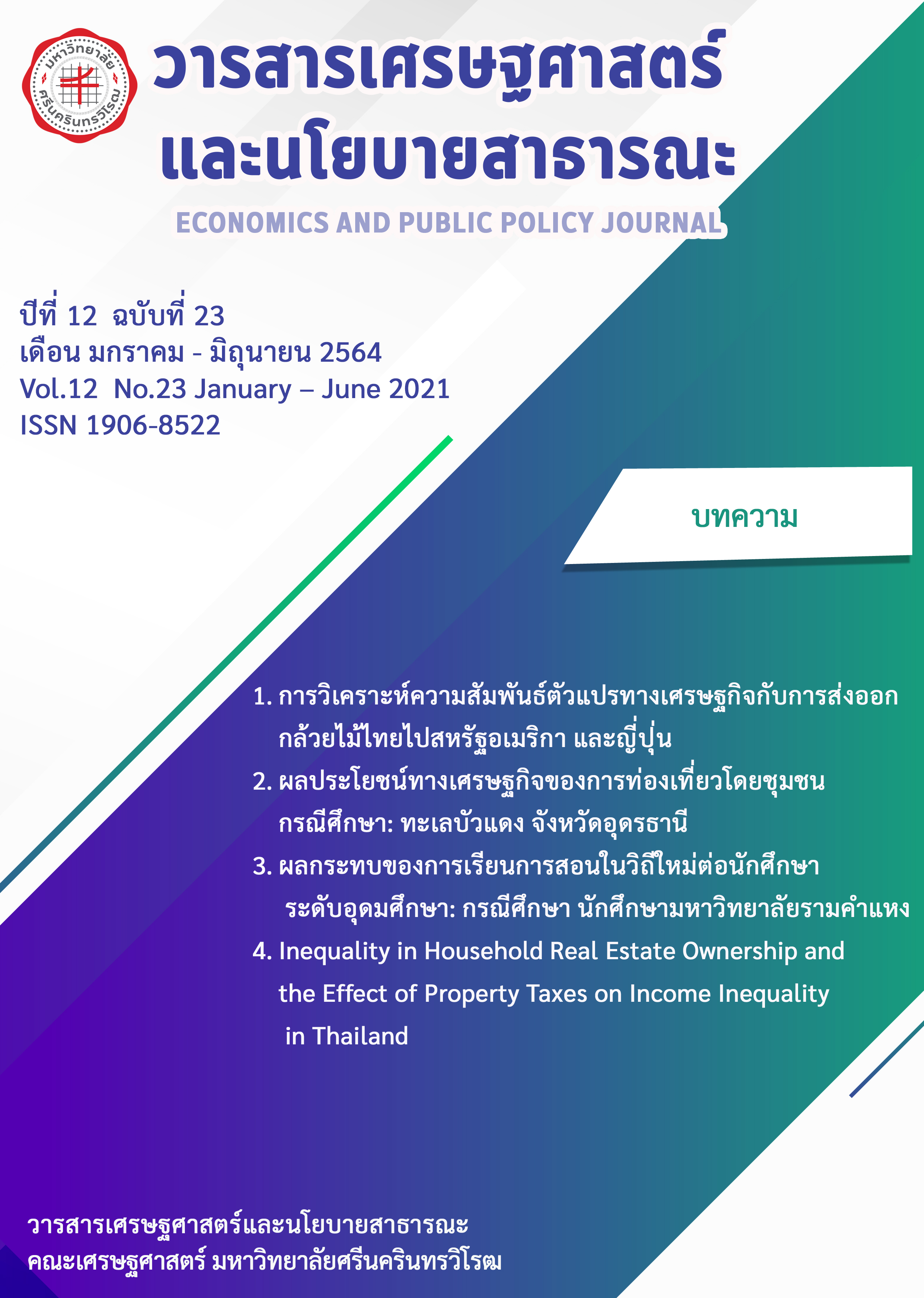Inequality in Household Real Estate Ownership and the Effect of Property Taxes on Income Inequality in Thailand
Main Article Content
บทคัดย่อ
Thai government replaces property taxes on real estate with land and building tax to increase local government revenue, improve tax administration, and reduce land concentration and price speculation. However, housing and farming property value less than 50 MB or 99.96% (DLA, 2018) are exempted. This study applies Shorrocks Index decomposition by income quintile, region and municipal area to measure income and assets inequality in Thailand over 2007-2017. Thai household income and assets from Socio-economic Survey (SES) is standardized with national statistics. The analysis is done under three scenarios: previous property taxes, land and building tax, and land and building tax without exemption. Inequality of assets were higher than income throughout the period. Majority of inequality stem from inequality in the Bangkok and urban area. The empirical results support the implication of land and building tax as the new tax law can generate much higher revenue for local government and better reduce inequality. Land and building tax can be levied on all property regardless their value as it would generate much higher revenue and household tax burden is rather small
Article Details

อนุญาตภายใต้เงื่อนไข Creative Commons Attribution-NonCommercial-NoDerivatives 4.0 International License.
สงวนลิขสิทธิ์ © 2553 คณะเศรษฐศาสตร์ มหาวิทยาลัยศรีนครินทรวิโรฒ
คณะเศรษฐศาสตร์ มหาวิทยาลัยศรีนครินทรวิโรฒ จัดพิมพ์วารสารเศรษฐศาสตร์และนโยบายสาธารณะ เพื่อเผยแพร่บทความวิชาการทางเศรษฐศาสตร์ นโยบายสารธารณะ และสาขาอื่นๆที่เกี่ยวข้อง ทัศนะและข้อคิดเห็นใดๆ ที่ปรากฏในวารสารเป็นความคิดเห็นส่วนตัวของผู้เขียน โดยบทความที่ได้รับการตอบรับจะถือเป็นลิขสิทธิ์ของคณะเศรษฐศาสตร์ มหาวิทยาลัยศรีนครินทรวิโรฒ
บรรณาธิการ อาจารย์ ดร.พลพัธน์ โคตรจรัส
เอกสารอ้างอิง
Alvaredo, F., Chancel, L., Piketty, T., Saez, E., & Zucman, G. (2017). Global inequality dynamics: New findings from WID. world. American Economic Review, 107(5), 404-409.
Ananapibut, P. (2012). Tax Reform for Thai Social Equity. Chulalongkorn University. www.econ.chula.ac.th/public/publication/.../Poli/Full-Paper_tax_pan.pdf.
Armour, P., Burkhauser, R. V., & Larrimore, J. (2013). Deconstructing income and income inequality measures: a crosswalk from market income to comprehensive income. American Economic Review, 103(3), 173-177.
Collier, P., Glaeser, E., Venables, T., Manwaring, P., & Blake, M. (2017). Land and property taxes: Exploiting untapped municipal revenues. Policy brief.
Cowell, F. A. (1984). The structure of American income inequality. Review of Income and Wealth, 30(3), 351-375.
DLA. (2018). Essence of land and building tax Retrieved from www.oic.go.th › FILEWEB › GENERAL › DATA0000.
Jeong, H. (2008). Assessment of relationship between growth and inequality: micro evidence from Thailand. Macroeconomic Dynamics, 12(S2), 155-197.
Laovakul, D. (2013). The Concentration of wealth in Thailand. Complete research paper for Thailand Equality Project The study of Wealth and Authority Structure Reform Project. Chapter 2. . In. Political Economy Center: Chulalongkorn University.
Laovakul, D. (2016). Concentration of land and other wealth in Thailand. Unequal Thailand: Aspects of Income, Wealth, and Power, 32-42.
Laovakul, D., & Phijaisanit, E. (2008). Fiscal Policies for Income Redistribution. Economic research and trainings center, Thammasart University.
Lerman, R. I., & Yitzhaki, S. (1985). Income inequality effects by income source: a new approach and applications to the United States. The review of economics and statistics, 151-156.
Mookherjee, D., & Shorrocks, A. (1982). A decomposition analysis of the trend in UK income inequality. The Economic Journal, 92(368), 886-902.
NESDC. (2017). Thailand’s Poverty and Inequality in 2017. Retrieved from Office of the National Economic and Social Development Council:
Paweenawat, S. W., & McNown, R. (2014). The determinants of income inequality in Thailand: A synthetic cohort analysis. Journal of Asian Economics, 31, 10-21.
Pyatt, G. (1976). On the interpretation and disaggregation of Gini coefficients. The Economic Journal, 86(342), 243-255.
Saez, E., & Zucman, G. (2016). Wealth inequality in the United States since 1913: Evidence from capitalized income tax data. The Quarterly Journal of Economics, 131(2), 519-578.
Sarntisart, I. (2011). Income Distribution Analysis Measurement and economic Modeling. Bangkok: Chulalongkorn University press.
Shorrocks, A., & Wan, G. (2005). Spatial decomposition of inequality. Journal of Economic Geography, 5(1), 59-81.
Shorrocks, A. F. (1982). Inequality decomposition by factor components. Econometrica: Journal of the Econometric Society, 193-211.
Shorrocks, A. F. (1984). Inequality decomposition by population subgroups. Econometrica: Journal of the Econometric Society, 1369-1385.
Shorrocks, A. F. (2013). Decomposition procedures for distributional analysis: a unified framework based on the Shapley value. The Journal of Economic Inequality, 11(1), 99-126.
Suisse, C. (2019). Global Wealth Report 2019 Data Book.
Techarungnirand, K. (2003). Recommendation on property tax reform.
Wasi, N., Paweenawat, S., Ayudhya, C. D. N., Treeratpituk, P., & Nittayo, C. (2019). Labor Income Inequality in Thailand: the Roles of Education, Occupation and Employment History. Retrieved from


